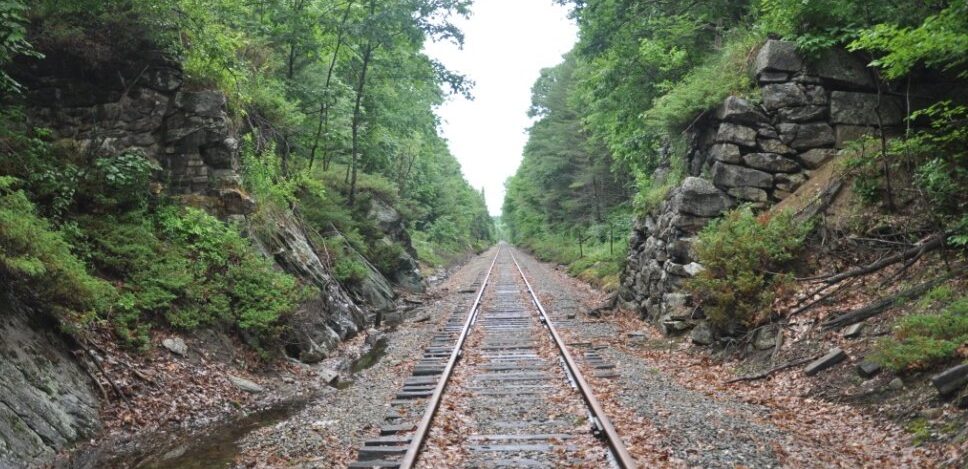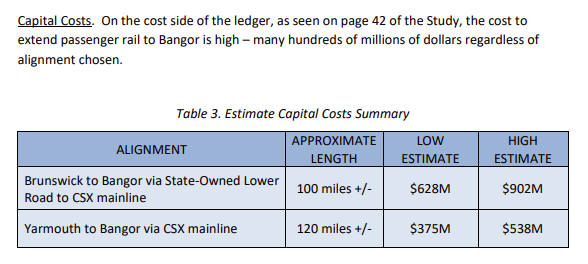
Last week, the Maine Department of Transportation released the final report on its Bangor Transit Propensity Study, reviewing the viability of transit options between Portland and Bangor. Among other routes, the study considered the viability of passenger rail along the Lower Road corridor — the route of the proposed Merrymeeting Trail.
The study’s conclusions are unambiguous and compelling. Specifically, the report reviews and analyzes the data collected during the study and recommends working with “the current intercity bus operators in the corridor to advance a 2-year pilot to provide additional round trips and/or adding additional stops or route deviations.”
With respect to the potential for passenger rail service, the report is clear:
Given the relatively low transit demand, low population densities, high capital and operating costs, low climate and equity benefits, and extensive transportation needs statewide, MaineDOT has determined that it would be imprudent to continue the study of extending passenger rail to Bangor at this time.
The report delineates the Department’s rationale in each of these areas (low demand, high cost, low climate and equity benefits, etc.). Importantly, it also estimates the ticket price for a one-way train ride between Bangor and Brunswick to be $116, assuming an annual taxpayer-funded $9.3 million subsidy — and on top of nearly $1 billion in capital costs to upgrade the infrastructure on the line.


In terms of projected ridership, the Department pegs current demand at low levels — the equivalent of approximately five buses a day — and projects it to stay low through at least 2040:
The Study estimated that a new or improved transit service could serve between 56,000 – 80,000 trips per year, or about 153 to 219 trips per day in 2023, and between 62,250 – 87,650 trips per year, or about 171 to 240 trips per day, by 2040.
(Emphasis added)
Given this low demand, MaineDOT further notes that a project to restore passenger rail service in this area is unlikely to be eligible for federal funding — a critical component in being able to afford the high costs:
A new rail service will not meet minimum thresholds for ridership or corridor density needed to qualify and successfully compete for Federal Transit Administration commuter rail funding at this time. Further, from a Federal Rail Administration (FRA) intercity rail perspective, the Bangor rail concepts do not provide a time competitive alternative to highway travel and do not address any significant highway congestion in a corridor nor does it connect major urban areas. These are all important criteria used by FRA when ranking discretionary intercity rail projects.
(Emphasis added)
In presenting these conclusions to the Transportation Committee of the Legislature, this same sentiment was echoed by other important Maine organizations who were opposing bills to spend more money studying passenger rail on these corridors. These groups included the Northern New England Passenger Rail Authority (NEPRA), the Portland Regional Chamber of Commerce, CSX, and the Bangor Area Comprehensive Transportation System (BACTS).
BACTS also included a letter with MaineDOT’s final report on the study. In it, the organization focused on improving transit in the greater Bangor area made this powerful statement:
BACTS recognizes the appeal of extending passenger rail service to Bangor, however, the significant capital costs associated with the rail alternative appears to outweigh the benefits and conflicts with our goal of maintaining fiscal responsibility for transportation investments in the greater Bangor region. Alternatively, BACTS would support MaineDOT investing in enhancements to the existing intercity bus services and local services in the study area.
These conclusions from MaineDOT, BACTS, and other Maine transit organizations inject an important dose of reality into the discussion about the viable near-term future uses of the Lower Road corridor. It also makes clear that the choice Maine faces is not between using that corridor as a trail or using it for passenger rail, but rather between using it as a trail or continuing the status quo — which is to say using this languishing public asset for nothing at all, as been done for decades.
Are you ready for Maine to create the Merrymeeting Trail? Please share your support for the Merrymeeting Trail with MaineDOT’s Rail Corridor Use Advisory Council. It only takes a moment to submit a comment, and the more the Council hears that the community wants to put this corridor to use for the benefit of local towns, the more likely this project is to happen. Thank you!